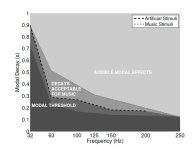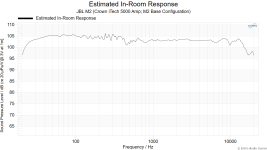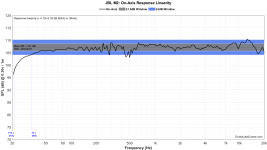vsWhen talking about perception one cannot exclude the rooms effect and the source directivity - it's simply impossible.
"Design for a room" is an utter nonsense in the first place. We can hear "through" the room quite easily as long as the room is not a total disaster. The better the speakers alone the better the sound in the room. It's as easy as that.
I don't look to pit one against the other, rather looking for Clarity, no pun intended =) @gedlee in past discussion you have commented about our ability to hear and separate the room from the Loudspeaker. I think it may have come with some conditions, possibly ER levels, LR arrival times. Forgive me if I am asking in repetition. What are those conditions that one can expect separation of room from loudspeaker. I guess this is the same as asking where is the separating line allowing us to perceive Direct Sound from Indirect. I understand that at LF there is no separation. Maybe that is key? Above the modes of the room, is Direct vs Indirect easily distinguished from each other? I am speaking of On-Axis performance.
This might be useful.
The "target" decay curve (attached below) was provided in : Fazenda, Bruno M., Stephenson, Matthew and Goldberg, Andrew (2015) Perceptual thresholds for the effects of room modes as a function of modal decay. The Journal of the Acoustical Society of America, 137 (3). pp. 1088-1098. ISSN 0001-4966
The "target" decay curve (attached below) was provided in : Fazenda, Bruno M., Stephenson, Matthew and Goldberg, Andrew (2015) Perceptual thresholds for the effects of room modes as a function of modal decay. The Journal of the Acoustical Society of America, 137 (3). pp. 1088-1098. ISSN 0001-4966
Attachments
I should think the opposite (if you mean perceived sound level.) Psychoacoustics has shown that the perceived sound level will no longer increase once several periods have elapsed. This means that decreasing the decay rate will result in louder perceived LFs than high. But at some decay rate there will be no difference.I think that because of short cycle time of HF, a balanced spectral decay MS wise, will lend to higher perception of the HF vs the LF. Any truth to this?
Well at LFs one can never separate the room from the loudspeaker, they are a single system. At HFs our ear/brain can acclimate to the sound decreasing the rooms effect, but it is always there to some extent - the extent being determined by the rooms design. High DI tends to minimize the rooms effect.I don't look to pit one against the other, rather looking for Clarity, no pun intended =) @gedlee in past discussion you have commented about our ability to hear and separate the room from the Loudspeaker. I think it may have come with some conditions, possibly ER levels, LR arrival times. Forgive me if I am asking in repetition. What are those conditions that one can expect separation of room from loudspeaker.
The separation depends on the timing of the early reflections. If they arrive early enough to "mingle" with the direct sound then the direct and indirect cannot be distinguished resulting in a smearing of the image. This all changes with frequency as the eare can process HFs much faster than it can LFs.I guess this is the same as asking where is the separating line allowing us to perceive Direct Sound from Indirect. I understand that at LF there is no separation. Maybe that is key? Above the modes of the room, is Direct vs Indirect easily distinguished from each other?
Addendum:
I am well aware of the argument for "room gain" the fact that a source placed on a wall doubles its power output and in a 2D corner doubles again and in a 3D corner doubles again. Thus in a room the power output is increased by the presence of the walls. But this ignores the fact that the room is closed while my examples above assume an open sound field. The closed room reflects the sound back into the corners and that changes everything resulting in modes rather than pure gain.
I am well aware of the argument for "room gain" the fact that a source placed on a wall doubles its power output and in a 2D corner doubles again and in a 3D corner doubles again. Thus in a room the power output is increased by the presence of the walls. But this ignores the fact that the room is closed while my examples above assume an open sound field. The closed room reflects the sound back into the corners and that changes everything resulting in modes rather than pure gain.
Periods/cycles is what is accurate. Same x value of periods 20-20khz, is what is truly uniform decay.By Burst Decay I guess I should have said Period? One could judge decay by MS or by Periods. I think that because of short cycle time of HF, a balanced spectral decay MS wise, will lend to higher perception of the HF vs the LF. Any truth to this?
View attachment 1441310
If its in ms, it is ever increasing delay by frequency according to the wavelengths in question, and therefore not uniform over the spectrum.
Last edited:
This is not true, it depends on the source directivity. A piston will have a falling power response but a CD waveguide will not. This is a critical reason why they will sound different.
Hello
OK I see what you are saying looking at the on axis and in-room predicted on the M2 from Erin's measurements. There is a slight step but it's darn flat over the waveguide. You can see it drop up high where the directivity narrows. So if you had these in an HT wouldn't you use a sloped target curve? Won't these sound a bit bright as is depending on the room if you leave them flat.
Rob 🙂
Attachments
Last edited:
Someone interested in a completely neutral response. I mean we are speaking preference. If you prefer a highly analytical sound a very neutral response is where its at. If the system can play down to 30hz or lower, when voiced flat it isn't going to sound bass-less at all.
Correct, many of the so called high end speakers sound 'bass heavy'.
This is not true, it depends on the source directivity. A piston will have a falling power response but a CD waveguide will not. This is a critical reason why they will sound different.
This (imho) touches on camplo's rather unique objectives.
Wow that is very clarifying! I really appreciate your perspective, its crazy how easily one can explain things after so much time thinking about them but at the same time, the truth is really right there in front of our faces.I should think the opposite (if you mean perceived sound level.) Psychoacoustics has shown that the perceived sound level will no longer increase once several periods have elapsed. This means that decreasing the decay rate will result in louder perceived LFs than high. But at some decay rate there will be no difference.
I answered both of my questions with one answer. 🤦♂️🤦♂️🤦♂️
I get what you are saying. At the end of the day, we end up with constructive and deconstructive interference, and the trend line, the averaging through the peaks and nulls will result in less gain that some claim to expect, simply by the addition of barriers common to the average listening room, aka closed room.The closed room reflects the sound back into the corners and that changes everything resulting in modes rather than pure gain.
I agree with this, which is why my target curve is a few dB rise at LFs and a few dB cut at HFs.So if you had these in an HT wouldn't you use a sloped target curve? Won't these sound a bit bright as is depending on the room if you leave them flat.
I believe that there is a misspelling and "delay" should be "decay".If its in ms, it is ever increasing delay by frequency according to the wavelengths in question, and therefore not uniform over the spectrum.
I am not going to speak on what might happens behind closed doors lol! but I have spent time, into developing my PPSL, in order to provide better FR than I've shown in the past. If all is consistent with my simulations, I should be able to completely remove the Null of the PPSL and at the very least, will easily be able to cross at 300hz or higher, where, there is no discrepancy on headroom through the crossband. The Horizontal polar transition from Horn to woofer section is wide to wider, and at 300hz we are still in the modal region of the room where such a transition can make sense. By squeezing another set of woofers in to play, the horn is at my desired ear height and headroom of the woofer section on one channel is handled by 4076sqcm of accumulated Sd. I have proven that there is enough headroom even at a 200hz steep crossing, by measuring thd closely at the compression drivers exit, horn removed but ignore that for now lol. When I simulate my TMM in Vituixcad, the nulls or lack there of, on the vertical axis are very encouraging.(I hope you wouldn't make that mistake.)
The Sources are modelled as having no Directivity, crossed at 300hz LR24.... With the actual directivity of the horns and cabinets, the polar will not look like above... it will look... even better?
All as a two way 😊
Last edited:
True, but camplo's horns are 'slightly' different.Hello
OK I see what you are saying looking at the on axis and in-room predicted on the M2 from Erin's measurements. There is a slight step but it's darn flat over the waveguide. You can see it drop up high where the directivity narrows. So if you had these in an HT wouldn't you use a sloped target curve? Won't these sound a bit bright as is depending on the room if you leave them flat.
Rob 🙂
Arez, read his comment, it shows the applied truth!Periods/cycles is what is accurate. Same x value of periods 20-20khz, is what is truly uniform decay.
If its in ms, it is ever increasing delay by frequency according to the wavelengths in question, and therefore not uniform over the spectrum.
I should think the opposite (if you mean perceived sound level.) Psychoacoustics has shown that the perceived sound level will no longer increase once several periods have elapsed. This means that decreasing the decay rate will result in louder perceived LFs than high. But at some decay rate there will be no difference.
Key sentence "Psychoacoustics has shown that the perceived sound level will no longer increase once several periods have elapsed"
That would only be true of a very small room. In a normal listening room the Schroeder frequency is about an octave lower. But all this is highly room dependent. In my room it's at about 100 Hz because of the high LF damping.at 300hz we are still in the modal region of the room
Well theres that then ☺️ Both the horn and the cabinets are of similar width, the horn, only a few inches wider but both loosing directivity before the xover. Polar match at xover achieved.
I bought some fiberglass fabric, because in the sales picture, it looked nice to me, but to my dismay, upon opening the package, there were already, strands of misplaced weave...

So, I've re-evaluated my efforts, and I see a way, that is simpler and using materials I already have, and have worked with. 👷
I bought some fiberglass fabric, because in the sales picture, it looked nice to me, but to my dismay, upon opening the package, there were already, strands of misplaced weave...
So, I've re-evaluated my efforts, and I see a way, that is simpler and using materials I already have, and have worked with. 👷
Research tells us that people in general prefer a speaker that is more flat on axis than not.
The reason why these research results are almost meaningless is that while there is only one flat response, there are an infinite number of non-flat responses. It's obvious—if you compare a speaker with the worst possible response to one with a flat response, anyone would prefer the flat one. Therefore, this does not deny the existence of non-flat response speakers that people might universally perceive as sounding better than flat response speakers.
That said, in practical terms, based on my experience, a reasonable approach is to first make the speaker's response as flat as possible and then start voicing from there.
- Home
- Loudspeakers
- Multi-Way
- Is it possible to cover the whole spectrum, high SPL, low distortion with a 2-way?


